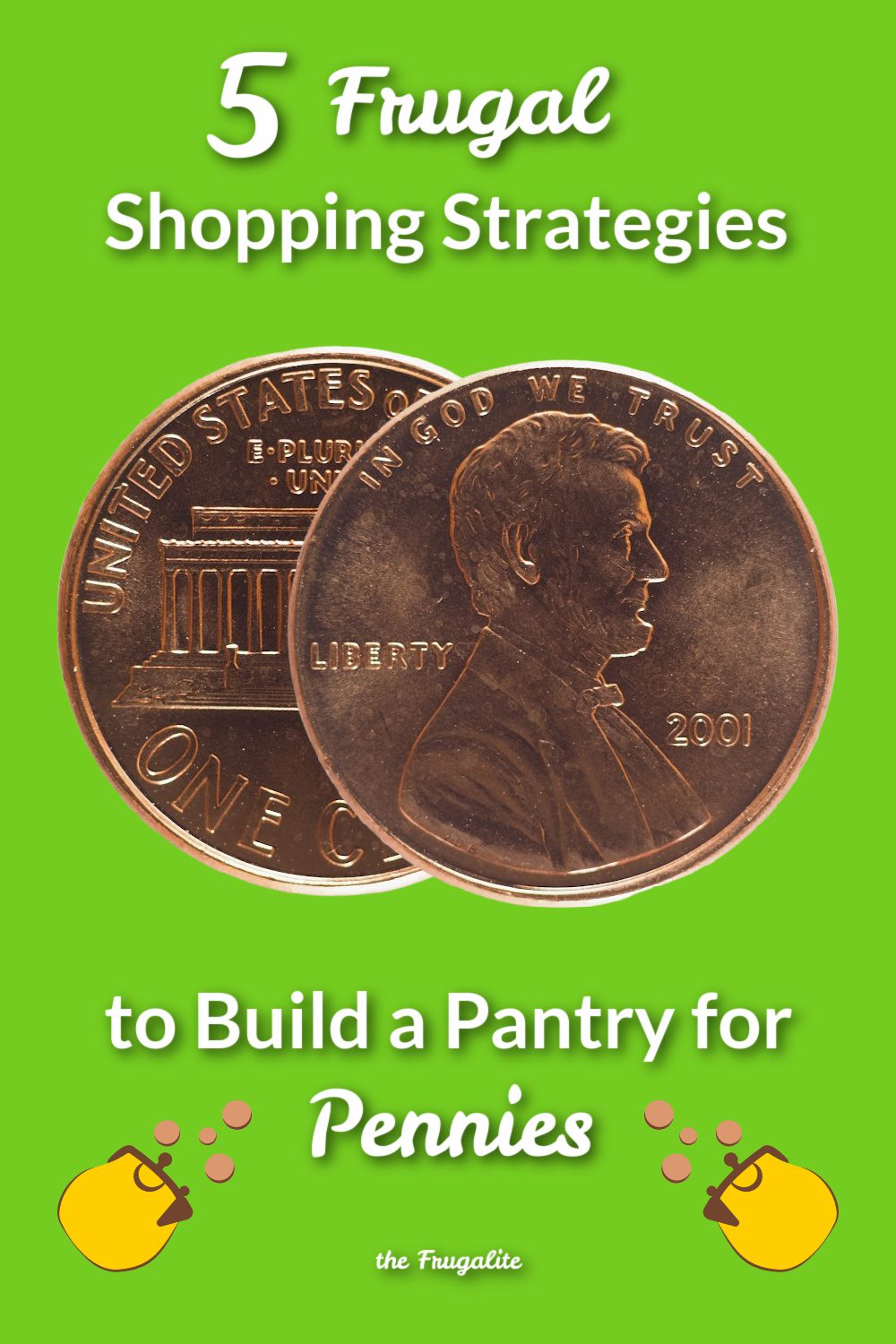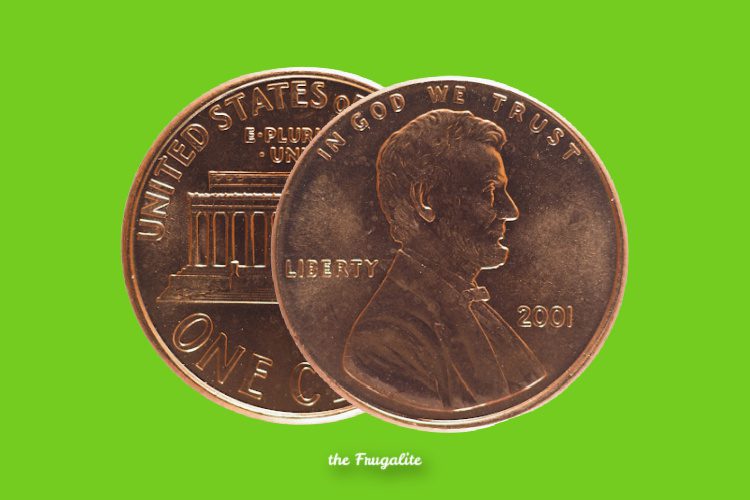(Psst: The FTC wants me to remind you that this website contains affiliate links. That means if you make a purchase from a link you click on, I might receive a small commission. This does not increase the price you’ll pay for that item nor does it decrease the awesomeness of the item. ~ Daisy)
It’s time to learn how to build a pantry for pennies. Do you wish you had one of those nice, well-stocked pantries bursting with food but feel like your budget makes it impossible? Thrift is of the utmost importance if you want to be able to afford to build your pantry quickly.
The fact is, a pantry is a work in progress and a whole new type of personal economy. You can save a fortune on your food budget by shopping carefully and in quantity.
A Well-Stocked Food Pantry is an Investment
Purchasing food at today’s prices is a great hedge against tomorrow’s increases. The cost of food will only be going up. Your pantry is your insurance against the economic crisis, unemployment, drought, pestilence, bad weather, and rising prices.
Take peanut butter, as an example: About 8 years ago, I purchased a store-brand peanut butter for $1.88 per jar when it was on sale. The following year, that very same brand in the very same sized jar was $5.99 on sale because of a poor peanut harvest. Each jar of peanut butter on the shelves represented a savings of $4.11 – there is no other investment that gives you over a 200% return.
Here’s Why I Keep a Well-Stocked Pantry
When I was first married and had a newborn baby, I was struggling to put food on the table with our tiny grocery budget. Then, as life often has it, things got even worse when my husband got laid off. We had a few dozen bags of sale-purchased bagels in our freezer, a few jars of peanut butter in the pantry, and high hopes for the garden we had just planted. Our situation was desperate, and the new little addition to our family added to our panic.
As we rationed out our bagels with peanut butter over the next few weeks, waiting for unemployment insurance to finally kick in, my husband frantically searched for a job and I became determined to never be in such a position again. (Think Scarlett O’Hara waving her dirty fist around.)
Since we had absolutely no money for entertainment, the library was my saving grace throughout this time. One day, searching for answers among the shelves, I stumbled upon a series of books by Amy Dacyczyn called “The Tightwad Gazette“. These three volumes gave me a whole new perspective on grocery shopping and is still the shopping basic philosophy I adhere to today. (By the way, I highly recommend the books – you can get one big compendium containing all 3 titles for less than $15.)
The TG recommends something called “The Pantry Principle.” It’s a process that saves both time and money. The idea is to consistently stock up on items at the lowest possible prices, creating a supply of ingredients at rock-bottom cost. This means sometimes you have to say no to preparing a meal just because it sounds good. You have to discipline yourself to adhere to a whole new way of shopping that does not supply just food for the week but replenishes your pantry, again, at the lowest possible prices.
#1 Create a Price Book
First, start a “price book” – this is a vital tool. Without it, you can’t really be sure if that sale is really a sale at all. A price book is simply a notebook that you keep with you when shopping, into which you write down the price that you pay for certain items. You should always update your price book with the lowest price for these items. This is what allowed me to see that at one point I paid $1.88 for peanut butter and a year later the lowest price I could find was $5.99, like I mentioned above.
In The Tightwad Gazette, Amy Dacyczyn wrote:
My price book is a small loose-leaf binder. Each page contains prices for one item, and the pages are in alphabetical order for quick reference. I include my code for the store name, the brand, the size of the item, the price, and the unit price.
I began by writing down prices on sale flyers and from my grocery slips. I made a few trips to compare prices of specific items. It quickly became evident that not every sale was really a sale. But when I did find a good buy, and I could verify it with months of records…what power! I could stock up with confidence.
At first you may think this is too much work and the idea of shopping at so many stores will be inconceivable. It will pay off. A good strategy is to shop at different stores each week of the month so that within a 30-day cycle you can hit them all. We have our shopping system down to once a month with only a few short trips to hit unbeatable sales.
[A price book] revolutionized our shopping strategy more than anything else we did. For the first time we had a feeling of control over our food budget.
It might take you a total of five hours to make up a price book for comparison shopping, but after several years of supermarket excursions, you may discover that your hourly “pay” for those five hours was over $1,000.
You’ll discover all sorts of trends with this type of record-keeping:
- Your local sales cycles
- When certain items tend to be loss leaders
- Which stores are consistently cheaper for specific ingredients
- Whether a highly promoted sale is actually a good deal or not
- Whether a big package of whatsits is a better deal than individually purchased whatsits at a different store
Speaking of sizes…
#2 Always Calculate the Unit Price
Be sure to record the size of the package you are purchasing so that you can accurately calculate the unit price. A unit price is vitally important. If you happen to go to one of those giant, members-only warehouse stores like Costco or Sam’s Club, you may discover that although a huge package seems like a good deal, it was actually cheaper to purchase the items in smaller quantities elsewhere.
The unit price tells you the cost per ounce, per gallon, per pound, etc., of what you want to buy.
Just divide the cost by the quantity. Here’s an easy-peasy example:
$100/25 pounds = $4 per pound
The goal is to compare the unit prices to find the best deal. Here’s an example of this:
- 2 pounds of chocolate at $3.80
- 1.5 pounds of chocolate at $2.70
In this case the unit is 1 pound, and the unit prices are:
- $3.80/ 2 pounds= $1.90 per pound
- $2.70/ 1.5 pounds = $1.80 per pound
You know how most businesses try to convince you the bigger package is always the better deal? That’s not always the case. In this situation, the second package of chocolate, although a smaller quantity, is actually a better bargain.
Another reason you must compare unit prices as opposed to simply grabbing a package that looks the same is the sneaky maneuver that food manufacturers use of reducing the contents of a package and selling it for the same price as before. For example, one company used to sell 1 pound cans of coffee. As prices went up, it appeared their price was the only one to remain the same. However, reading the label showed that they had reduced the amount of coffee in the can to 14 ounces. This misleading marketing ploy will become even more common as production prices continue to rise.
#3 Turn Pennies into Dollars
Now that you know you can confidently identify a good bargain, let’s move on to the next step in your new shopping style: saving pennies that add up to dollars.
When you find a staple at a good price, purchase in as much quantity as you can afford and reasonably use before it expires. This will allow you to begin building your stockpile. After a couple of months of shopping in this manner, you’ll discover that you don’t actually “grocery shop” anymore – you shop to replenish your stockpile.
Items that you stockpile should be foods that you regularly consume. If you normally eat steak and potatoes, for example, but you fill your pantry with beans and rice, when the day comes that you are relying on that pantry you will suffer from “food fatigue” and you will also feel deprived. Start now by adjusting the food that you consume on a regular basis to foods that will be sustainable in a food storage pantry.
Once you have the hang of it, you can apply this same pantry principle to nearly everything that you purchase. Your pantry doesn’t have to stop at the kitchen. Use this theory to keep your household running smoothly on far less money!
- Soap
- Toilet paper
- Shampoo
- Kitty litter
- School supplies
- Garbage bags
- Toothpaste
You get the idea – anything that you normally purchase, if you purchase it at deep discount, will add up to tremendous savings.
You may be saying, “Wait a minute, Daisy. I don’t have time to run all over the place just to save 10 cents here and 25 cents there. This is ridiculous.”
It’s not as crazy as it sounds. Here’s why.
It’s a cumulative savings.
Think about a cart full of groceries during a weekly shopping trip. You might have 100 items in your cart for the week ahead, right.
So, let’s say you save 10 cents on every single item in your cart. (Which, when you’re shopping like this is a very low savings – you’ll probably save far more.)
- In a cart with 100 items, you’ve saved $10 in a week.
- If you do that every single week over the course of an entire year, you’ve saved $520.
If you apply this to everything you purchase, can you see how quickly this could add up for you? You can save thousands of dollars per year and have a loaded pantry, ready to sustain you through emergencies.
#4 Plan your shopping trips with the precision of a military maneuver.
If you’re driving without a plan all over the place to hit the sales, you aren’t really going to save enough money to make it worthwhile in most cases. You should shop with a plan in order to maximize your time and fuel costs.
Most areas distribute free weekly flyers to your house. These are good for more than just lining the bottom of the litter box. If you are in an area where you don’t get sales flyers, you can generally find them online.
These sales flyers will help you to identify “loss leader” items that are geared to get customers in the doors. The loss leader is simply the unbeatable, oh-my-gosh-what-a-sale bargain to get you in the door at which point they hope you’ll purchase other dramatically overpriced items just because you’re there. This is a technique usually used by big corporations, so I have no qualms whatsoever about beating them at their own game and stopping JUST to purchase the loss leader items in quantity.
It isn’t always worthwhile to go far out of your way to purchase the loss-leaders, though. You have to establish a sensible route and pick up sale items along the way. Wasting half a tank of gas just to save 50 cents per item isn’t thrifty at all.
Spend a couple of hours each week writing down the sales that seem good. Then, check your price book and compare the unit costs. Are the advertised items really a good deal?
While I do recommend making a list, it’s vital to remember, the list is not the Gospel – it is just a guideline. You know how some of those websites preach strict adherence to your lists and menus? Ignore them!
Here’s why: Let’s say you have a whole chicken on your list, but chicken is outrageously expensive this week. But, pork is on sale. Doesn’t it make a lot more sense to take that into consideration? Be flexible.
For the thriftiest possible shopping trip, your list should include:
- Items that you have coupons for
- Sale items, listed by store, that are a good deal
- Must-have items, like milk if you have small children (there should be very few must-have items – flexibility is the key to a barebones budget!)
- Ingredients that you require for your meal plans (again, this should be flexible – also, don’t waste money on an ingredient that you can only use in one dish if your budget is tight!)
- Map your route before you go – if you have several stops to make, do so efficiently and without backtracking.
- Organize your lists by store
If a store is out of the way from the other shops you plan to hit, think about the week ahead. Do you have any errands or obligations that will take you to that store? There is a warehouse store about an hour away from us. Any time we have an appointment in that city, we plan ahead to allow some extra time to stop at the warehouse store and stock up.
When embarking on an afternoon of sales shopping, it can be a good idea to put some ice in a cooler for housing perishable food. Try to plan to pick up most of the perishable items on your last stop.
Here are a few more tips to help you keep the budget under control if you are spending an afternoon stockpile shopping:
- Eat before you go – hunger can impair your judgment because everything just looks so darned good!
- Take a bottle of water or a cup of coffee with you so that you aren’t tempted by the coolers or the Starbucks at the front of the store.
- Go alone – it is always far more expensive with a spouse or a child in tow. Admit it, who among us hasn’t bought something frivolous just to make another family member happy?
#5 Make bulk purchases
It gets even better when you begin purchasing in bulk quantities instead of grocery store quantities.
Let’s look at some more math – and you’ll see why maintaining a pantry beats out weekly grocery shopping every time.
I purchase my beef in bulk from a local farmer through a butcher shop. They raise hormone-free meat, the cattle are grass fed, the animals are treated humanely, and the quality is superior. Because I purchase 1/4 of a cow each year, I’m able to get all of my beef at $3.99 per pound.
Compare this to the grocery store (and we’re only talking about price, not the superior quality of the meat purchased farm direct): the best price this week for stewing beef was $4.99 per pound. The best price for ground beef was $2.99 per pound. The best price for roast was $9.99 per pound. When you average all of these together, I pay slightly more for ground beef and far less for everything else. As well, I have the added benefit of excellent quality meat that is cut and wrapped to order, and I’m avoiding the nasty chemicals and factory farming practices that taint the grocery store meat. The average grocery store price per pound, on sale, is $5.99
· Pantry method: $3.99 per pound
· Regular shopping method: $5.99 per pound
Now, for another example, let’s look at grains.
When I lived in Canada, I bought organic wheat berries. I paid $17.04 for 10 kg (about 22 pounds). The shipping was $21.78, bringing my total to $38.82, delivered to my door – or $1.76 per pound. I couldn’t get wheat berries at the local store. I had to drive an hour and 15 minutes to get them, resulting in a tank of gas. At the closest place I could find wheat berries, the cost in bulk is $2.60 per pound. Yes, I could buy a smaller amount, but purchasing the larger amount also results in savings because of fewer trips to the store. (Now that I’m in the United States, I purchase my grains online.)
Most food calculators recommend 300 pounds of wheat per person per year. This would be wheat for making bread, pasta, cookies, and other baked goods. If you are buying your wheat already processed into bread, pasta, and cereal, the price continues to climb.
· Pantry method: $1.76 per pound
· Regular shopping method: $2.60 per pound
At $1.76 per pound, that costs $529 per year. Per person. At $2.60 per pound, that costs $780 per year. Per person. If you can do this with all of your staples, you can see the savings that can be achieved. That is over $1000 per year for a family of four, for just one item.
Some of the things I buy in extremely large quantities are:
- Beef
- Sugar
- Wheat
- Cornmeal
- Oatmeal
- Coconut Oil
- Quinoa
- Beans
- Popcorn
- Tomatoes
- Dry milk
You’ll be astonished at how life-changing it is to shop for your pantry instead of to fulfill your weekly grocery list. Stock up and prepare for that rainy day that could be just around the corner. And if the rainy day never comes, you’ve saved time and money while providing healthy food for your family.
Do you shop for a pantry?
Do you use a pantry-building method for food shopping? Do you have some tips you can share with us? Let’s discuss it in the comments.
(Be sure to check out my book on building a cheap pantry on a budget, Prepper’s Pantry. This method works whether you’re a prepper or someone who wants an insurance policy in your kitchen cupboards.)













8 thoughts on “5 Frugal Shopping Strategies to Build a Pantry for Pennies”
My family has purchased this way for decades. My parents were children of the Depression, and adults during World War II. Many things were simply not available at all times. In my early adulthood, I was very broke, so I learned to shop carefully. Some of these practices have become automatic for me and my siblings. I finally got some acknowledgement from my spouse when the lockdown hit. We couldn’t go to the store, and we were just fine. My parents method was a little different– Dad would write the price and date on top of canned goods, so he always knew what the last price was that he had paid.
If you’re looking for store sale sheets online, check out http://www.flipp.com. They have more sale sheets than you ever wanted to see!
It really does help to have a bottle of water and a couple of snacks . I have to take my children with me. I pack lunch boxes for them and print out some new colouring sheets for the trip. Our closest large supermarket is 1 1/2 hour away. I also make sure they know that after the shopping is done we get a play at the park before a car picnic on the way home. I use a large Esky or cooler with reusable ice bricks . I also take a shopping list on a clipboard. Which always gets looks but I don’t care. The kids are also given a clipboard, my daughter likes to play inspector and my son likes to draw pictures which saves my shopping list for being drawn on. I usually shop on the days I know the meat is being marked down saving lots. I found shopping monthly saves heaps , on petrol, on stress and time as a round time takes 5 hours. Another tip I’ve found is I put a treat for the supermarket in the front seat, something small a favourite museil bar or lollypop, way cheaper to give that to the kids after filling up for petrol than an over priced chocolate bar from the petrol station. And I found the key is being consistent, stick to your plan every month.
It doesn’t hurt to check out stores like Dollar Tree or Dollar General, for example. Milk and salt at DG were cheaper last week. Be careful at Dollar Tree; cans of green beans, for example, will cost less at the grocery store. But I have found really good deals there.
There is not one place around here that sells in bulk, so I watch the sales and stock up then.
My problem is more of a storage issue. Under the bed is full!
Just one more tip: be sure to mark on the can or container the expiration date. I found a whole carton of expired food that had to be tossed. Wasteful.
Also consider store brands! They can be cheaper than buying with coupons and of equal quality. Definitely buy in bulk when things are on sale, especially nonperishables.
This is how I shop. We get store sale sheets in the mail every Wednesday so I circle what I am interested and compare between prices between stores. I pay attention to those sheets because i have noticed that some stores have the same items are for sale every two weeks or the same week of every month. I go to ethnic stores because sometimes prices are lower for larger amounts (especially herbs, nuts and spices) because the item is an essential to their way of cooking or eating. I make my shopping trip a circle starting at the first store leaving my house and ending with the last store leading to my house. Also we have Albertsons here and I love $5 Friday! Every week they have about 10-12 items for $5, $5/lb or 2for $5. If I have extra change I buy extra household essentials like soap and toilet paper. Things like TP are personal choice but I like Scotts 1000 sheets per roll 1ply but I don’t like Scotts price! I found our Aldi’s brand is called Willow. It is a 12 count ,1000 sheets per roll for $7.00. My issue however is storage space. Most times I repackage items to create space using containers from a US store called the Dollartree and Ziplock bags.
I haven’t been buying much for a while. After covid we lived on the pantry for months.
Then I started restocking. Moneys been hard to come by for a while. I finally had to put my husband on hospice and accept food from a community food pantry. I buy carefully. I always did but now its not just bargains. It is volumn I look for when I spend money. Yes I compare prices. I look for things I’ll enjoy. Not just cheap junk. I season carefully and well. Seasonings are a planned part of my purchases.
I don’t have access to a dehydrator so I watched for dehydrated foods on sale. I paid less that $8 per #10 can of dehydrated potato slices. I do compare. I search online for things I want. Our rural country town stores are very poorly stocked. I’ve ordered a lot with free delivery far cheaper than it is to drive to town for shopping. I have Y2K #10 cans folks were giving away. If it’s good for 25 years it’s good for a few more years. Price was free. Found on Craigslist free things.
I was stocking up for two of us. Recently I’ve added 2 widow ladies with young grandchildren they are raising so I’m figuring to share with them them while they are now actively storing food and meds for their family. I’ve found a free pressure canner for one family. I’ve asked the other lady to bring her mothers old canners and learn to can.
As of today my personal preps are just for one. I feel like we three ladies need each other. Those little kids need to be provided for.
I haven’t seen a store circular in the mail since 2009 (and I live in the burbs). There used to be circulars in the local paper every Wednesday, but I dumped the local rag in 2012. Instead I visit store web sites when I create my shopping lists.
I create my weekly menu based on 1) what’s in my freezer, then 2) what’s in my pantry, then 3) what’s on sale. Only lastly do I consider an “Hey honey, any ideas for dinner on Friday,” meal idea.